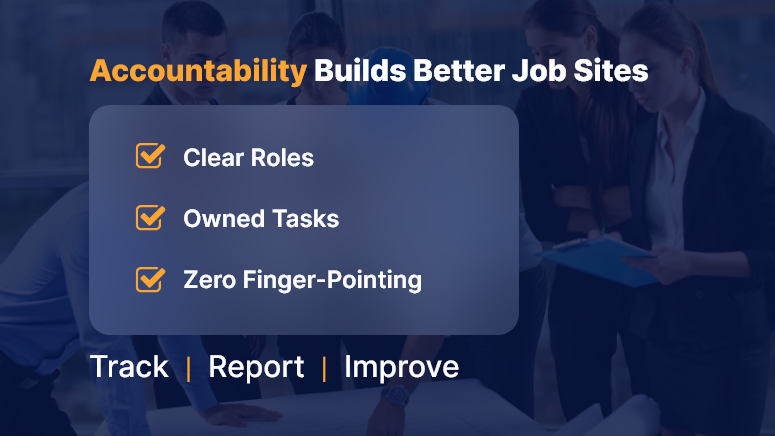In the construction industry, missed deadlines and miscommunication cost billions annually. A McKinsey report revealed that large projects typically run 80% over budget and 20 months behind schedule. What’s the common thread? A lack of accountability.
Construction accountability isn’t just a buzzword. It’s the backbone of trust, consistency, and performance on job sites. When teams take ownership, delays shrink, rework reduces, and safety improves. But creating that culture doesn’t happen by chance—it’s built intentionally.
In this blog, we’ll break down how to create a culture of accountability in construction teams, why it matters, and how platforms like OConstruction empower it with clarity, transparency, and digital oversight.

Business Relevance & Why It Matters
Without accountability, even the best project plans fall apart. Construction is fast-moving, decentralized, and unpredictable. From the field to the back office, unclear roles or shifting responsibilities often create delays, disputes, and finger-pointing.
When construction accountability is embedded into your culture:
- Team members own outcomes, not just tasks.
- Foremen and PMs communicate proactively.
- Mistakes turn into learning loops, not blame games.
- Compliance and safety are easier to enforce.
Common Problems Due to Low Accountability:
- “I thought they handled it” situations leading to missed inspections.
- Repetitive rework from unclear instructions or ignored checklists.
- Safety audits failed because logs were incomplete or falsified.
Who Benefits Most:
- Project Managers: Stay on top of progress and team performance.
- Site Supervisors: Gain visibility into who’s doing what.
- Executives & Owners: Track results, not just hours.
Construction accountability, supported by digital tools, shifts teams from reactive to proactive. And that shift directly impacts your project timelines, budgets, and bottom line.
Best Practices, Frameworks, and Actionable Strategies
The Foundations of Construction Accountability
- Set Clear Expectations from Day One
Start every project with crystal-clear roles, responsibilities, and deadlines. Don’t leave it to verbal agreements—document everything using digital project briefs or onboarding forms inside your platform.
- Tie Tasks to Owners, Not Just Teams
Saying “the plumbing team will fix it” creates ambiguity. Assign tasks to individuals, not groups. Tools like OConstruction let you assign and monitor work down to the crew member level.
- Use Checklists to Eliminate Assumptions
Standardized digital checklists ensure no critical step is skipped. You’ll also have proof of work, which is crucial for quality assurance and audits.
Do’s and Don’ts for Fostering Team Accountability
Do: Conduct Daily Standups
Short, focused meetings keep crews aligned and surface blockers early.
Don’t: Micromanage
Trust your teams to deliver. Use performance dashboards for insight, not control.
Do: Track Progress Visually
Use visual boards or Gantt views to keep stakeholders on the same page.
Don’t: Tolerate Blame Culture
Shift the tone from fault-finding to future-focused improvement.
Step-by-Step Framework for Building Accountability
Step 1: Create Role-Based Dashboards
Customize dashboards for each role—PMs, foremen, field workers—to see only what’s relevant. This removes clutter and sharpens focus.
Step 2: Integrate Digital Logs and Time Tracking
Daily logs build real-time accountability. With timestamped digital entries, everyone knows who was on-site, what was done, and what’s pending.
Step 3: Set SLAs for Internal Tasks
Service-level agreements aren’t just for vendors. Use them internally to define turnaround times for approvals, inspections, and handoffs.
Step 4: Reward and Recognize Ownership
Create incentive programs around reliability, timeliness, and collaboration. Celebrate accountability publicly in team huddles or platform leaderboards.
Customer Story / Use Case Example
For example, IronStone Builders, a mid-sized construction firm, used OConstruction’s task ownership tracking to assign clear deliverables to field supervisors.
Before the switch, delays in concrete pouring often stalled other crews. After implementing digital task assignments and daily log reviews:
- Task rework dropped by 40%
- Average project timeline reduced by 12 days
- Team meetings became solution-focused, not reactive
Here’s how: supervisors received daily alerts for their assigned tasks, and checklists ensured no steps were skipped. PMs had real-time dashboards to course-correct instantly.
Key Takeaways & Closing Summary
Creating a culture of construction accountability is not about tightening the screws. It’s about giving teams the clarity, structure, and tools they need to take ownership confidently.
- Clear expectations, checklists, and digital dashboards prevent miscommunication.
- Role-based task tracking boosts individual ownership and accountability.
- Real-time performance visibility allows faster interventions and smoother operations.
- A shift in mindset — from “who’s to blame” to “how do we fix it”— builds long-term resilience.
By investing in the right processes and platforms like OConstruction, construction leaders can embed accountability into the DNA of every project — turning it into a competitive advantage.



